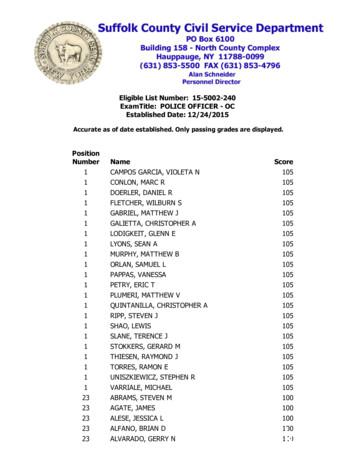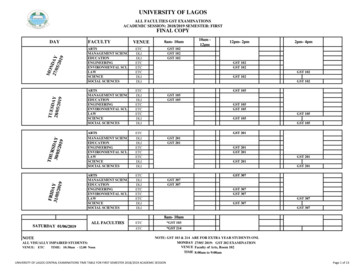ASTRONOMY 105 LABORATORY
ASTRONOMY 105 LABORATORYSummer II 2018(1:30 -3:20)PM TWR Miller Science 318Supervising Faculty: Dr. Robert FriedfeldEmail: rfriedfeld@sfasu.eduOffice Rm. 322I or 126 Miller Science BuildingPhone: 468-2197Office Hours (By appointment) July 10 - Aug.10, 2018Laboratory Assistant:CALENDARLab123456789101112DateJuly 10July 11July 12July 17July 18July 19July 24July 25July 26July 31Aug 01*WedAug 02Aug 07Aug 08Lab ExerciseNo LabThe MoonConstellations/Star ChartsExperimental MeasurementsMercury’s OrbitEmission SpectraThe Earth’s Orbital VelocityThe HR DiagramStellar Parallax/Distance to the PleiadesAges and Distances of ClustersNight Lab at 8:30 p.m.(Sky Observations)Hubble’s LawThe Rotation of Saturn/Review for LabExamLab Exam* Tentative Date: If the weather is cloudy or raining, we will reschedule the night lab.Night Lab Calendar(The night lab will be held at the Observatory)Lab SectionNight Lab20Aug 01* (Wednesday)
OUTDOOR NIGHT LABPlease read the following night lab guidelines carefully.1. Night labs will be held on specific dates and times at the SFA Observatory.You are required to attend only one of these labs.2. On the evening of your night lab, meet at the commuter’s bus stop (located behindthe Steen Library) a few minutes before the scheduled time. A bus will providetransportation to and from the SFA Observatory. The bus will leave promptly at thescheduled time, so don’t be late! (Note: You mustride the bus, use of personal vehicles is not allowed). It usually takes about 3 hours tocomplete the lab.3. The night lab will be cancelled if it is raining or the sky is completely overcast (it is notnecessary to show up at the bus stop if cloudy). If the weather looks questionable,the decision to ‘go’ or ‘cancel’ on a particular night, may not be made until shortlybefore lab time. Don’t get discouraged!4. Night lab is a required component of the Astronomy 105 lab program. The night labgrade cannot be dropped.SUPPLIESEach student MUST bring the following supplies to every lab session.1. Pencil and eraser2. Flashlight with RED filter3. Clear ruler with centimeter scale4. Laboratory Manual5. Star Chart (will be handed out at first lab)6. Calculator (bring to every lab!)CLASSROOM POLICIESEach week’s lab begins with a brief presentation by the teaching assistant (15-30minutes). Important instructions and procedures for completing the lab exercise aregiven at that time. At the conclusion of the presentation, students will then complete thelab exercise under the guidance of the lab assistant.1. Come prepared! Read over the lab exercise before coming to class (see calendar)and bring required materials (clear ruler, calculator).2. It is very important that you arrive on time or important instructions will be missed!3. Before and during this presentation there will be occasional clicker questions for youto answer. Make sure you are prepared for these questions by completing thereading assignment, reviewing the previous week’s lab exercise and being attentiveduring the presentation.4. Cell phones, pagers and other communication devices must be turned off duringclass.GRADINGThere are 12 grades that will be used to determine a lab average (11 indoor labs andthe night lab). The two lowest indoor lab grades will be dropped. The night lab is a
required lab and cannot be dropped. The lab exercises will count 70%, the clickeraverage 10% and the Lab Exam 20% of the FINAL LAB AVERAGE. FINAL LABAVERAGE (Average of Lab Exercises X 0.70) (Clicker Average x 0.10) (LabExam X 0.20) Astronomy 105 (Lecture) and Astronomy 105L (Lab) are averaged intoone grade and THE SAME GRADE WILL BE RECORDED FOR BOTH LECTUREAND LABORATORY. The FINAL COURSE GRADE is explained in your lecturesyllabus.LAB ABSENCESWe realize that occasionally there are legitimate reasons for missing labs (such asillness). We have madeaccommodations for excused indoor lab absences in your lab average by simplydropping the two lowestgrades. Warning: Do not miss lab for whimsical reasons! If you miss more than twolabs, your lab average will be reduced substantially. If three or more, you will fail thecourse.1. There are no make-up labs.2. Students will receive a grade of zero for each lab absence.3. Students must attend their assigned lab. Transfers from one lab section to anotherare not allowed.4. As always, students are responsible for missed lab material.ACADEMIC INTEGRITY (A-9.1)Academic integrity is a responsibility of all university faculty and students. Facultymembers promote academic integrity in multiple ways including instruction on thecomponents of academic honesty, as well as abiding by university policy on penaltiesfor cheating and plagiarism.Definition of Academic Dishonesty:Academic dishonesty includes both cheating and plagiarism. Cheating includes but isnot limited to (1) using or attempting to use unauthorized materials to aid in achieving abetter grade on a component of a class (homework, clicker, exams, lecture or lab); (2)the falsification or invention of any information, including citations, on an assignedexercise; and/or (3) helping or attempting to help another in an act of cheating orplagiarism. Plagiarism is presenting the words or ideas of another person as if theywere your own. Examples of plagiarism are (1) submitting an assignment as if it wereone's own work when, in fact, it is at least partly the work of another; (2) submitting awork that has been purchased or otherwise obtained from an Internet source or anothersource; and (3) incorporating the words or ideas of an author into one's paper withoutgiving the author due credit.Please read the complete policy at http://www.sfasu.edu/policies/academic integrity.aspPenalties may include no credit or failure in the course.CHEATING
WITHHELD GRADES SEMESTER GRADES POLICY (A-54)Ordinarily, at the discretion of the instructor of record and with the approval of theacademic chair/director, a grade of WH will be assigned only if the student cannotcomplete the course work because of unavoidable circumstances. Students mustcomplete the work within one calendar year from the end of the semester in which theyreceive a WH, or the grade automatically becomes an F. If students register for thesame course in future terms the WH will automatically become an F and will be countedas a repeated course for the purpose of computing the grade point average.The circumstances precipitating the request must have occurred after the last day inwhich a student could withdraw from a course. Students requesting a WH must bepassing the course with a minimum projected grade of C.STUDENTS WITH DISABILITIES:To obtain disability related accommodations, alternate formats and/or auxiliary aids,students with disabilities must contact the Office of Disability Services (ODS), HumanServices Building, and Room 325, 468-3004 / 468-1004 (TDD) as early as possible inthe semester. Once verified, ODS will notify the course instructor and outline theaccommodation and/or auxiliary aids to be provided. Failure to request services in atimely manner may delay your accommodations. For additional information, go tohttp://www.sfasu.edu/disabilityservices/
PERTAINING TO NIGHT LABThe SFA Observatory is 11 miles north ofmain campus on Highway 259 towardHenderson. Only the night lab will takeplace at the observatory.We will always meet at the Old Stone FortMuseum next to Miller Science Building. Where do I go to get on the bus?You must ride the bus to the observatory. Use of personal vehicles is not allowed. On theevening of your night lab, meet at the bus stop a few minutes before the scheduled time. Thebus will provide transportation to and from the SFA Observatory. The bus will leavepromptly at the scheduled time, so don't be late! It usually takes about 3 hours to completethe lab.
The lab exercises will count 70%, the clicker average 10% and the Lab Exam 20% of the FINAL LAB AVERAGE. FINAL LAB AVERAGE (Average of Lab Exercises X 0.70) (Clicker Average x 0.10) (Lab Exam X 0.20) Astronomy 105 (Lecture) and Astronomy 105L (Lab) are averaged into one grade and
ExamTitle: POLICE OFFICER OC Established Date: 12/24/2015 Accurate as of date established. Only passing grades are displayed. Position Number Name Score 1 CAMPOS GARCIA, VIOLETA N 105 1 CONLON, MARC R 105 1 DOERLER, DANIEL R 105 1 FLETCHER, WILBURN S 105 1 GABRIEL, MATTHEW J 105 1 GALIETTA, CHRISTOPHER A 105
gst 201 8am- 10am gst 102 gst 102 gst 102 gst 105 gst 105 gst 105 12pm- 2pm gst 102 gst 102 gst 102 gst 105 gst 105 gst 105 y 9 arts management sciences education engineering environmental sci. law law science social sciences arts day faculty science social sciences arts management sciences
CREF Social Choice Account R2 (variable annuity) QCSCPX 0.245 0.245 0.200 0.000 0.200 CREF Stock Account R2 (variable annuity) QCSTPX 0.290 0.290 0.200 0.000 0.200 iShares S&P 500 Index K WFSPX 0.030 0.030 0.000 0.105 0.105 MassMutual Small Cap Growth Equity I MSGZX 0.870 0.870 0.000 0.105 0.105 MFS Growth R6 MFEKX 0.530 0.530 0.000 0.105 0.105
Astronomy, Astrophysics, and Cosmology Luis A. Anchordoqui Department of Physics and Astronomy Lehman College, City University of New York Lesson VII March 29, 2016 arXiv:0706.1988 L. A. Anchordoqui (CUNY) Astronomy, Astrophysics, and Cosmology 3-29-2016 1 / 22
ASTRONOMY 101.004 INTRODUCTION TO ASTRONOMY PROFESSOR PATRICIA HENNING FALL 2014 Welcome to a unique astronomy experience! ASTR 101.004 is unique because it is held in the Domed Theater of the New Mexico Museum of Natural History and Science, which contains the highest technology proj
Astronomy Level 2 Preview Try it before you buy it! This file contains a PDF preview of RSO Astronomy 2: Introduction and TOC Chapter 1 - Introduction to Astronomy Chapter 2 - The Big Bang We recommend using the latest Adobe Reader or Adobe Acrobat version
Instructor’s Guide for Virtual Astronomy Laboratories Mike Guidry, University of Tennessee Kevin Lee, University of Nebraska The Brooks/Cole product Virtual Astronomy Laboratories consists of 20 virtual online astronomy laboratories (VLabs) representing a sampling of interactive exercises that illustrate some of the most imp
The Handbook has been prepared for University students as the textbook in English Phonetics. It can as well be used by the teachers and students of English at any level as a ‘guide’ to correct pronunciation. I am very grateful to my colleagues for reading the draft and giving me valuable recommendations for improving the material. 6 Section A THEORY What are the English sounds and how do .























